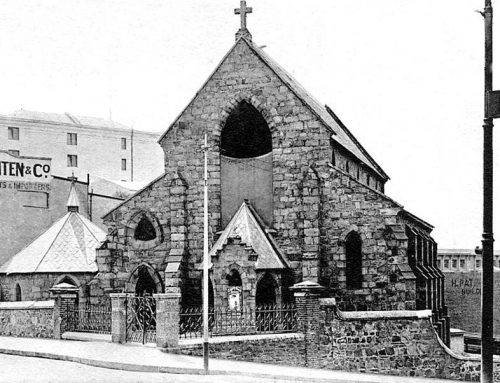
The rectangular edifice was erected during the First British Occupation and is the oldest theatre building in South Africa, having been erected for that purpose by the Governor, Sir George Yonge, on what is now Riebeek Square, where it was opened on 17th November 1800. Thus it is the only church building that was formerly a theatre. Under the Batavian regime the theatre was called the Afrikaansche Schouwburg, but to the populace it was simply known as the Komediehuis. The basement was and still is used for workshops, storage and similar purposes. The building, repeatedly menaced with demolition, was proclaimed a historical monument in 1965.
In connection with the emancipation of the slaves a service for freed slaves was held in St. Andrew’s Presbyterian Church on the 1st December 1838 by Dr. James Adamson, together with the Rev. G. W. Stegmann of the Evangelical Lutheran Church. These services, in which the two ministers took turns, continued, and the next year the theatre building was purchased for £3484 for adaptation as a church for ex-slaves and as a school for Coloured children. It is believed that it received the name of the first Christian martyr as a result of stoning by persons opposed to its establishment as a church for ex-slaves. It was consecrated on 30th April 1843. Under Stegmann a Sunday-school and regular Sunday services were held. He resigned from the Lutheran Church in 1847 and from that date to 1853 also held services in St. Stephen’s for 150 Lutheran dissidents until their new church was available in Long Street (the present German church).
The Coloured congregation of St. Stephen’s continued under Stegmann and in 1857 agreed to incorporation with the Dutch Reformed Church, their clergyman being legitimated as a minister of that Church. Stegmann, however, two years afterwards proceeded to the D.R. parish of Glen Lynden, where he remained until his death in 1890.
In response to many requests, directed to St. Stephen’s by freed slaves in other parts for some religious instruction, an organisation called De Apostolische Unie was established by that church, which ordained five missionaries and sent them to Caledon, Clanwilliam, Pniel, Wellington and Malmesbury, as well as two evangelists to Beaufort West and the Cape Flats.
For a long time the membership of St. Stephen’s consisted of both Whites and Coloured people, but eventually of Coloured people only. In 1972 the number of adherents was approx. 1000.
Bibliography:
J. Hoge: `Geskiedenis van die Lutherse Kerk aan die Kaap’,
Archives Year Book for S.A. History, Vol 2, 1938;
St. Stephen’s Ned. Geref. gemeente: Gedenkprogram, 1857-1957.
Photo acknowledgement: http://hubpages.com/travel/A-postcard-tour-of-old-Cape-Town



